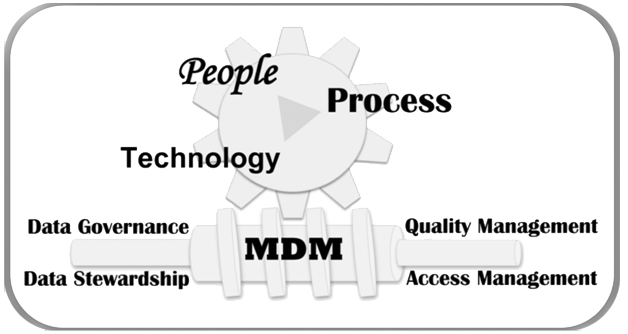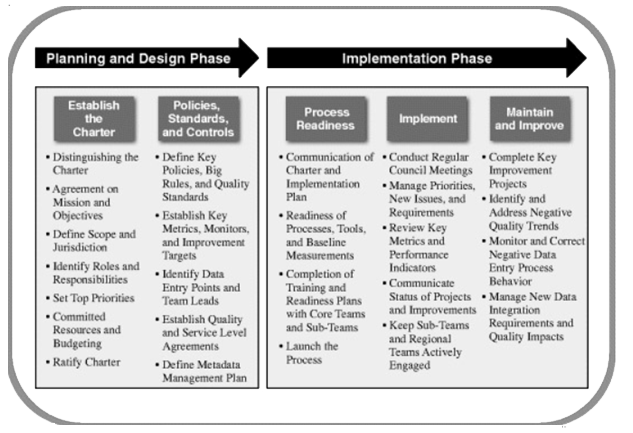Information Governance
Data Governance is a framework of accountabilities and processes for making decisions and monitoring the execution of data management. Data is a corporate asset and needs to be treated and funded as a corporate asset. We help the companies to know how a data management initiative will enhance the business. Unreliable data—whether about customers, products, or suppliers—hinders understanding and hurts the bottom line.
Concepts, Strategies, and Best Practices
Data governance involves processes and controls to ensure that information at the data level—raw alphanumeric characters that the organization is gathering and inputting—is true and accurate, and unique (not redundant).
Data governance focuses on information quality from the ground up at the lowest or root level, so that subsequent reports, analyses, and conclusions are based on clean, reliable, trusted data (or records) in database tables. Data governance is the most rudimentary level at which to implement information governance. Data governance efforts seek to ensure that formal management controls—systems, processes, and accountable employees who are stewards and custodians of the data—are implemented to govern critical data assets to improve data quality and to avoid negative downstream effects of poor data.
There are some general guidelines that can help improve a data governance program’s chances for success:
- Identify a measureable impact. A data governance program must be able to demonstrate business value, or it will not get the executive sponsorship and funding it needs to move forward. A readiness assessment should capture the current state of data quality and whether an enterprise or business unit level effort is warranted. Other key issues include: Can the organization save hard costs by implementing data governance? Can it reach more customers or increase revenue generated from existing customers?[2]
- Assign accountability for data quality to business units, not IT. Typically, IT has had responsibility for data quality, yet it is mostly not under that department’s control, since most of the data is being generated in the business units. A pointed effort must be made to push responsibility and ownership for data to the business units that create and use the data.
- Recognize the uniqueness of data as an asset. Unlike other assets, such as people, factories, equipment, and even cash, data is largely unseen, out of sight, and intangible. It changes daily. It spreads throughout business units. It is copied and deleted. Data growth can spiral out of control, obscuring the data that has true business value. So data has to be treated differently, and its unique qualities must be considered.
- Forget the past; implement a going-forward strategy. It is a significantly greater task to try to improve data governance across the enterprise for existing data. Remember, you may be trying to fix decades of bad behavior, mismanagement, and lack of governance. Taking an incremental approach with an eye to the future provides for a clean starting point and can substantially reduce the pain required to implement. A proven best practice is to implement a from-this-point-on strategy where new data governance policies for handling data are implemented beginning on a certain date.
- Manage the change. Educate, educate, educate. People must be trained to understand why the data governance program is being implemented and how it will benefit the business. The new policies represent a cultural change, and people need supportive program messages and training in order to make the shift.
MDM (Master Data Management) is about people, process, and technology. The proper combination of these three elements is what makes MDM successful.
Figure 1 represents people, process, and technology and MDM as a pair of gears. As one is adjusted, the other is impacted.
 Figure 1: Reliance between MDM and People, Process, and Technology
Figure 1: Reliance between MDM and People, Process, and Technology
As much as technology is clearly important, when companies start a Customer MDM program they are looking to solve a business need. It is a given business need that will drive what technology is required, and not the other way around. Obviously, in certain markets and industries, technology can be a strategic differentiator, and as such, it becomes a business priority in itself.
Defining and planning a Customer Data Governance (CDG) model should start with an initial assessment and the groundwork necessary to drive a sound charter and implementation proposal for your governance model. Involvement of a consultant in the planning phase of your governance initiative can also be a major benefit. Our consultants with a good track record in the MDM and data governance space can greatly assist in best practice evaluations, initial process or data quality assessments, gathering of metadata, evaluation of third-party MDM tools or services, preparation of reference material, or facilitation and planning of meetings.
Here is an example of our high-level CDG process design and implementation approach.
 Figure 2. MoxieWise CDG Process Design and Implementation Approach
Figure 2. MoxieWise CDG Process Design and Implementation Approach
